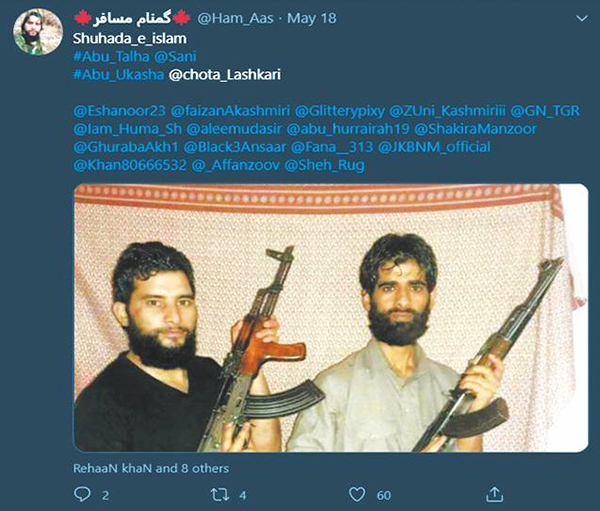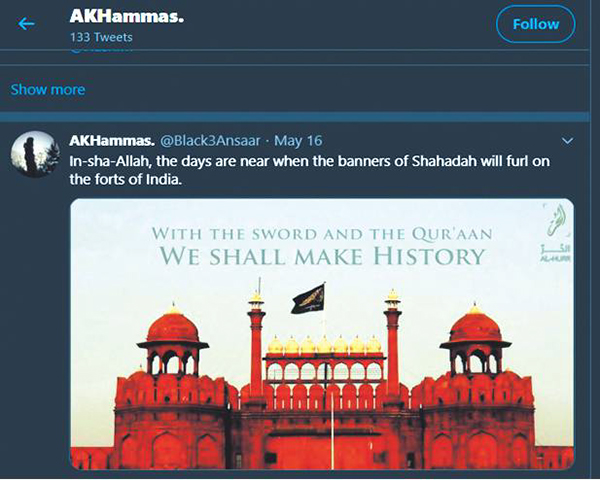This infiltration season, The Resistance Front (TRF) emerged as a new shadow for the Lashkar-e-Taiba (LeT), a terrorist organisation in Kashmir. The new group mainly aims to radicalise and carry out recruitments for the LeT.
TRF is an amateur group created on 12 October 2019, virtually on Telegram. In its nascent stage, the Indian intelligence community and the Indian Army decoded its make and model and declared it was an extended hand of Pakistan’s Inter-Services Intelligence (ISI).
It was a ploy by Pakistan to revive its terror operations in Kashmir under a new name much similar to the Hamas, an acronym of the Arabic phrase ‘Harakat al-Muq wama al-Isl-miyya’, meaning “Islamic Resistance Movement”.
Threat and Intent
Hostile social manipulation poses a larger threat than an active militancy itself. The virtual footprint of a terrorist’s image are birth grounds for otherwise amateurish terrorists like Burhan Wani and Zakir Musa. Their death has been encashed to further radicalise and recruit more innocent youth. Greater number of recruits for radical Islam-based terrorist organisations is a good indicator of radical Islamists’ hold in a conflict zone. In other words, the fire is still burning and the fuel will continue to be poured.
Numerous Islamist groups were formed in 1990 advocating Nizam-e-Mustafa (Rule of Muhammad) as the objective of their struggle. Murder of Kashmiri Hindus, intellectuals, liberals and activists was described as a necessity to get rid of ‘un-Islamic’ elements. Concurrently, all ‘sinful’ activities like cinema houses, beauty parlours, wine shops, bars, video centres, use of cosmetics and similar things were banned by the militant groups.
LeT, formed in 1987, is the armed wing of the Pakistan- based religious organization, Markaz-ud-Dawa-wal-Irshad (MDI), a Sunni anti-US missionary organization led by Hafiz Muhammad Saeed. The group construes lands once ruled by Muslims as Muslim lands and considers it as their duty to get them back. It embraces a pan-Islamist rationale for military action. LeT believes that jihad is the duty of all Muslims and must be waged until eight objectives are met:
• Establishing Islam as the dominant way of life in the world.
• Forcing disbelievers to pay Jizya (a tax on non-Muslims).
• Fighting for the weak and feeble against oppressors.
• Exacting revenge for killed Muslims.
• Punishing enemies for violating oaths and treaties.
• Defending all Muslim states.
• Recapturing occupied Muslim territory.
The Digital Footprint
The geography of cyberspace is much more mutable than other environments. Low barriers to entry make it an attractive option for hybrid warfare especially popular amongst international terrorists and rogues states like Pakistan with abysmal financial resources. Some experts believe that as virtual communities develop on the internet, they will cut across territorial jurisdictions and develop their own pattern of governance.
The key characteristics of any influence operation is its speed and reach.
Scrapping of Article 370 was a much-required political move to resolve the stalemate situation in Jammu & Kashmir. For decades, the stalemate situation otherwise provided fertile grounds for numerous back door deals between non-state actors and other organisations.
Analysis of open data on Twitter reveals that there was a spike in new accounts from October 2019 to March 2020, dedicated to promote terrorism in Kashmir or Pakistani narrative in Kashmir. Most of the accounts were from Pakistan. (See images).
There was a co-dependence trend observed amongst the newly created accounts wherein every new account was boosted by an already existing pool of similar accounts. These could not be classified under bots, trolls or sock puppets. These were multiple accounts organically created which were boosting terror-related content on social media.
Other kinds of twitter accounts are online media channels dedicated to Kashmir.
The online medium is primarily used by the terrorist groups like the ISIS or Al-Qaeda for radicalising young vulnerable minds. In 2009 Al-Qaeda launched an English e-magazine called Jihad Recollections. The ISIS launched ‘Dabiq’ under Al-Hayat (Life) Media Centre — the media house of the Islamic State. It was named after a famous Syrian town near the Turkish border where the ‘believers’ battled against the ‘infidels’. The LeT launched its online magazine in 2018 called ‘Wyeth’.
Terrorist organisations in Kashmir have always maintained a euphoria amongst the locals that their fight was for a bigger cause and that the people from different parts of the world were supporting it; that they should rather feel proud and not sad, if their son becomes a ‘Shaheed’ and not a literate civilised peace-loving human being.
It was reported in the beginning of 2020 that Pakistan Army’s media wing Inter-Services Public Relations (ISPR) was organising competitions every month to award youths whose tweets were retweeted the most. The prizes included a job and contracts with Fauzi Foundation run by the Army. Like other ideas of Pakistan, this one is also borrowed from a state where the word ‘disinformation’ originated.
Defence against Online Radicalisation and Extremism
It is widely established that cutting down access to the Internet cannot be a long-lasting solution. Even in the absence of Internet, there are 15 Pakistan-based FM stations that are active in Jammu & Kashmir spreading propaganda against India.
The Twitter handle of Pakistan’s prime minister Imran Khan is also used for the same purpose, to amplify the narratives.
The counter-strategy cannot be a ‘tit for tat’ or a battle of whose narrative is louder.
Democratic states are more vulnerable to information warfare as they do not believe in building their own cyber-wall like Russia, Iran or China. Hence, the other option is to create cyber policies under which social platforms like Google, Facebook, Twitter, Instagram, Telegram and others take a responsible step in preventing radicalisation and extremism.
Big Data giants like Google, Facebook, Amazon, e-Bay and other internet companies that are used every day to track and profile their users have established relations with the US military and intelligence agencies.
According to Yasha Levine, the author of Surveillance Valley, “over the years, Google had supplied mapping technology used by the US Army in Iraq, hosted data for the Central Intelligence Agency, indexed the National Security agency’s vast intelligence databases, built military robots, co-launched a spy satellite with the Pentagon and leased its cloud computing platform to help police departments predict crime.’’
While India satisfies the appetite of data giants as the next promising market, it sure can strike some deals to preserve its own national security interests.




















